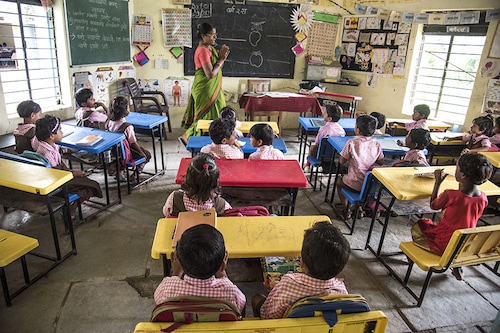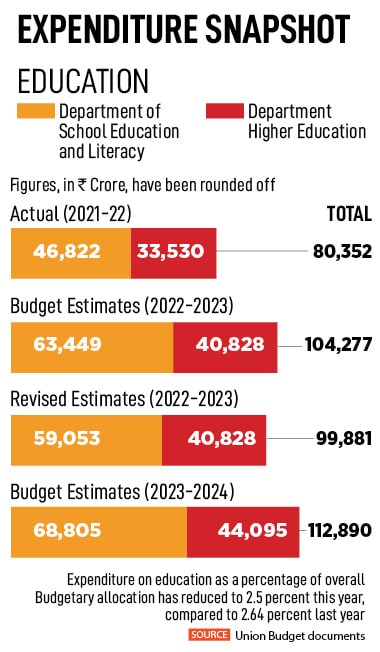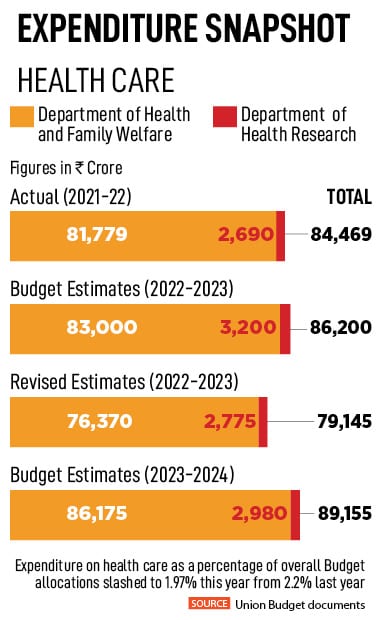Budget 2023: Health care, education left wanting
At a time when education and health care are considered priorities for post-pandemic recovery, the Union Budget sets the right tone in terms of a few long-term, forward-looking plans, but has crucial


In her Union Budget speech on February 1, Finance Minister Nirmala Sitharaman announced a few provisions related to health care, education and skilling under a priority titled ‘Inclusive Development’. This included provisions targeted at skilling, research and increase in manpower, like establishment of nursing colleges, multidisciplinary courses for medical devices, national digital library for children and adolescents, and new programme to promote research and innovation in pharmaceuticals through centres of excellence (more in the box ‘Announcements’).
Spending towards both health and education has increased in terms of absolute numbers compared to last year, but reduced marginally as a percentage of overall Budgetary allocations. The Budget Estimates towards health care for 2022-23 stood at Rs86,200 crore for the ministry of health, which was revised to Rs79,145 crore for the same period. The estimated outlay this year is Rs89,155 crore. While health care spending occupied about 2.2 percent of the Budget last year, it reduced to 1.97 percent this year (see box).

In education, the allocations have increased from Rs10,4277 crore (Budget estimates 2022-23) and Rs99,881 crore (Revised estimates 2022-23) to Rs112,890 crore this year. Expenditure on education as a percentage of overall Budgetary allocation has reduced to 2.5 percent this year, compared to 2.64 percent last year (see box).
The New Education Policy (NEP) envisaged that spending on education would be at least 6 percent of gross domestic product (GDP). While we are heading nowhere close to that for a variety of reasons, including the global economic slowdown in the wake of the Covid-19 pandemic, an important indicator to keep in mind is effective implementation followed by Budgetary announcements. “Are we just announcing new initiatives, or do we have the wherewithal to take it to completion?" asks Narayanan Ramaswamy, national leader of education and skill development practice, KPMG India.

He points to how there is no information on completion or impact created by the supposedly pathbreaking education initiatives announced in the previous Budgets, like digital universities or the Higher Education Financing Authority (HEFA), which was set up as an agency to give interest-free loans to colleges and universities. As per Budget documents, from last year’s Rs0.01 crore, the allocation has been reduced to nil this year.
“There should be continuity of initiatives and funding, so that what we announce actually happens on-ground. There should be equal emphasis," says Ramaswamy, who adds that he is “disappointed" that the Budget has not provided for large-scale, deep-rooted teacher reforms and faculty development, which he calls ‘most important’ for the improvement of the education sector and must be taken on a “war footing".
In the Budget, the finance minister announced teacher training through “innovative pedagogy, curriculum transaction, professional development, dipstick surveys, and ICT implementation". More details on the implementation are awaited.
Mayank Kumar, co-founder and MD of edtech company upGrad, says the Budget provisions will drive digital transformation of the economy. “The promotion of online learning through Mission Karmayogi and the IGOT platform will further drive the adoption of digital technologies, even across rural and remote regions," he says. “Another significant milestone includes the focus on setting up more AI [artificial intelligence] and 5G labs and R&D centres, and the need for a skilled talent pool to support this adoption."
Prateek Maheshwari, co-founder of edtech unicorn PhysicsWallah, believes that the national digital library for children and adolescents will modernise and advance the economy, and the skill enhancement initiative is a “necessary tool for future growth and success". The Budget speech also said that over the next three years, the Centre will recruit 38,800 teachers and support staff for the 740 Eklavya Model Residential Schools that cater to 3.5 lakh tribal students. The estimated allocation towards these schools has increased from Rs2,000 crore in 2022-23 to Rs5,943 crore this year.
Ramaswamy of KPMG in India says that while new initiatives signal the “right intent" and are “forward-looking", one must be careful to ensure that benefits don’t just keep accruing to those with access to internet and digitisation, but also measure impact on the underserved and marginalised schools and children who continue to learn without internet access and digital devices.
While the health care sector is welcoming of new Budget announcements related to innovation in pharmaceuticals through centres of excellence, multidisciplinary courses for medical devices to ensure availability of skilled manpower and establishing nursing colleges, a few basic asks of the health sector remain unmet, according to experts.
“Dedicated investment towards nursing colleges will help our country fill the gap of nurses per patient ratio as per WHO standards. According to 2019 data by the Ministry of Health and Family Welfare, India had only 1.7 nurses for every thousand people compared to three nurses per thousand people requirement. The Covid-19 years have increased this gap even more and it is same for doctors and other paramedic staff," says Sandhya J, group chief financial officer (CFO), Narayana Health.

That said, she adds that while R&D got some attention, the expectation was for the Budget to increase health care expenditure to at least 2 to 2.5 percent, with a dedicated focus towards primary and secondary care. “While 157 medical colleges have been established since 2014, we still have far less doctors than we need and the country needs significant reforms in improving the accessibility and availability of medical education," she says.
Meena Ganesh, co-founder and chairperson, Portea Medical, says that while the Budget has encouraging announcements—like access to ICMR labs and other facilities, centres of excellence in artificial intelligence, establishing nursing colleges—“we hope for timely and adequate execution of the same in the months ahead".
In a call with Forbes India, she also says it is “slightly disappointing" that while most of the indicators announced cater to medium-term and long-term, there is nothing at all about how to improve access to primary health care. “A crisis situation like the pandemic toppled health care systems globally and some clarity on how the country will handle a similar situation in the times to come was needed," she says.
Hasmukh Rawal, MD of Mylab, says one of the most significant health care announcements in the Budget was the focus on creating awareness, screening and eradicating sickle cell anaemia. In South Asia, the highest prevalence of sickle cell disease (SCD) is in India, with over 20 million patients, he says. “It is widespread among the tribal population in India where about one in 86 births among Scheduled Tribes (STs) have SCD. Hence, early diagnosis is critical."
The decision to provide multidisciplinary training for development of medical devices and support for the manufacturing of devices will be a key enabler for the domestic medical devices industry, says Runam Mehta, CEO of HealthCube. “Opening up facilities in select ICMR labs for research by private and medical colleges will enable better infrastructure access for both individuals and organisations who are looking at undertaking research and innovation in this area."
First Published: Feb 01, 2023, 18:09
Subscribe Now